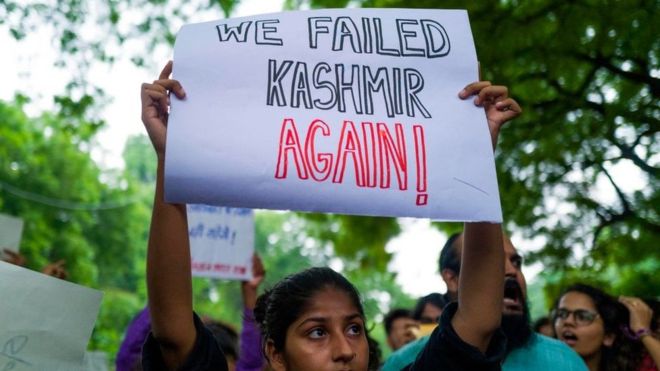Amidst outpouring sympathies after the failure of the Chandrayaan 2 mission, questions arise on “losing communication”. Read why mainland India has forgotten Kashmir from its memory.
Chandrayaan 2, India’s second lunar mission was meant to explore an area never explored before, the south pole of the moon. On 7th September, as the Vikram lander began its descent to the lunar surface, the country watched carefully. Just 2.1 kilometres over the surface of the moon, ISRO abruptly lost contact with the lander. The rover was found on 8th September, with a possibility of a harsh landing. At the time of writing this article, NASA promised to send pictures of the landing region and the rover for ISRO’s analysis.
A wave of social media sympathy took over. People immediately took the responsibility – for being proud of ISRO and for the failure of their efforts – into their own hands. A video of Prime Minister, Narendra Modi, and the ISRO Chairman, K. Sivan, emerged where Sivan can be seen wiping away his tears. Trolls took to mansplaining a female engineer who worked on the mission. Hate politics on social media also emerged between India and Pakistan, leading nowhere.
On social media and otherwise, the issue was widely compared to the communication blockade in Kashmir. Importantly, analogies were drawn between ISRO’s loss of communication with the Chandrayaan and the Kashmiris’ loss of connection with the rest of the world. “I want to know how India feels, knowing that there is no connection even in modern times like these. It also raises questions about if India is progressing at all,” a student from Kashmir said, under the condition of anonymity. “On one hand you claim the knowledge of the moon, but Kashmir has gone back several decades with a complete gag on communications for (now) more than 40 days.”
The Kashmir Valley has been under clampdown since 5th August, the day Article 370 was abrogated. Curfews have been imposed almost regularly. The clampdown has also been criticised for its authoritarian and colonial nature. Freedom of the Press no longer exists in the Valley and reports of violence, curfews, and killings have emerged as the Indian state urges that “the situation is normal”.
It is interesting that people chose to mourn the lander, a non-living object, instead of an entire state of over six million under clampdown. The poignant question to ask is this: if the people of this state are your own citizens, why are you not worried about their repression yet?
The insensitivity of the masses adds to the absurdity of the situation; as if it is normal for a population to exist without phone networks and the internet for more than a month! The common argument that the Bharatiya Janata Party propagates is that people lived before there was the internet. Yes, but the times have changed and because of an ambiguous “threat from militants”, it is not justifiable to keep human beings deprived of their civil rights.
The Kashmir clampdown is no longer seen in the mainstream media channels or the front pages of newspapers. Kashmir has been an object of selective outrage, or rather, an intermittent outrage.
Dr. Dharan Sharma, a senior aerospace engineer at NASA, said, “The timing of this mission was wrong, the mission seemed to have bleak chances of success. The economic crisis means every penny is priceless. The failure of this mission could mean the loss of what India has gained on the international space platform. It will weaken the flow of investment in science and technology.”
Many scientists on Twitter refused to call Chandrayaan 2 India’s greatest scientific feat since it takes away the light from other fields of science which lack funding.
India has been seeing disasters from multiple sides – be it the floods, the Kashmir issue, the economic crisis, or now the failure of Chandrayaan. What remains to be seen is how the Government deals with them to ensure that no more damage, than has already been made, is endured.
Feature Image Credits: BBC
Maumil Mehraj
Jaishree Kumar


